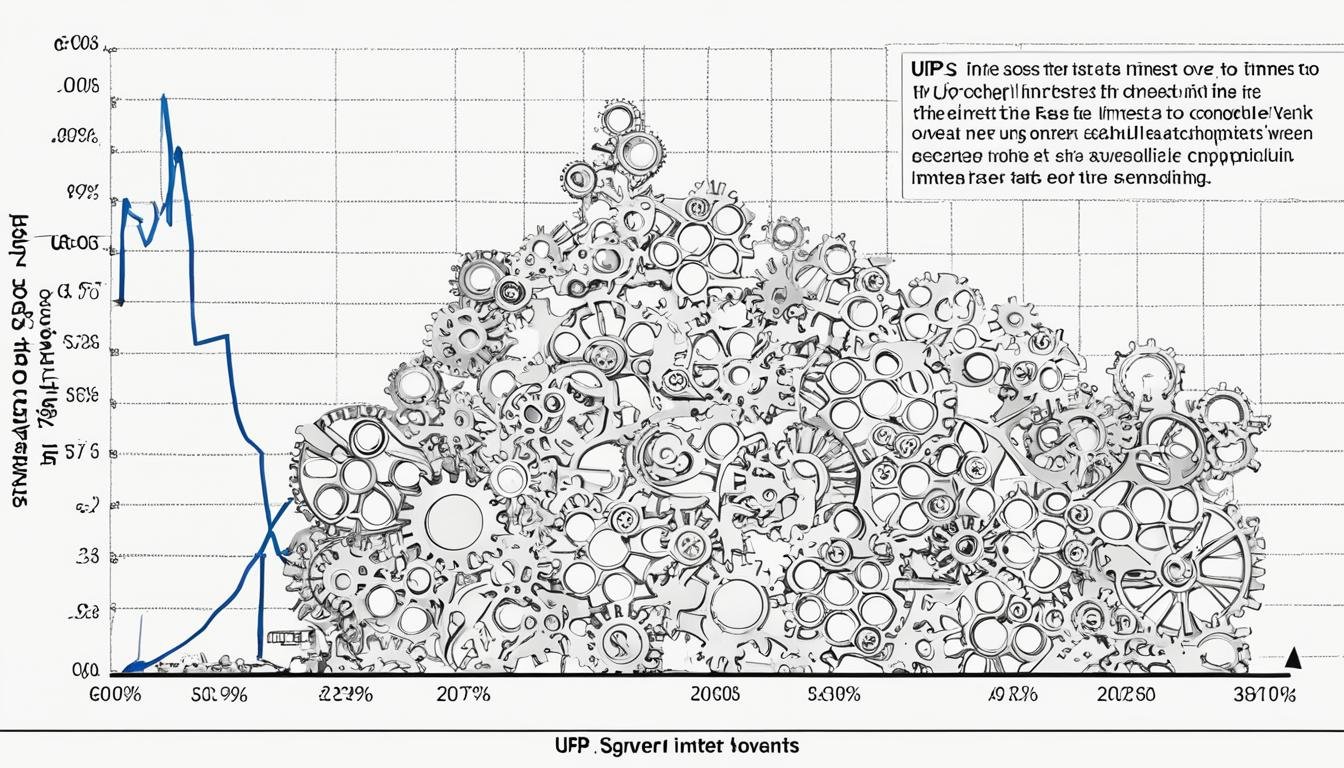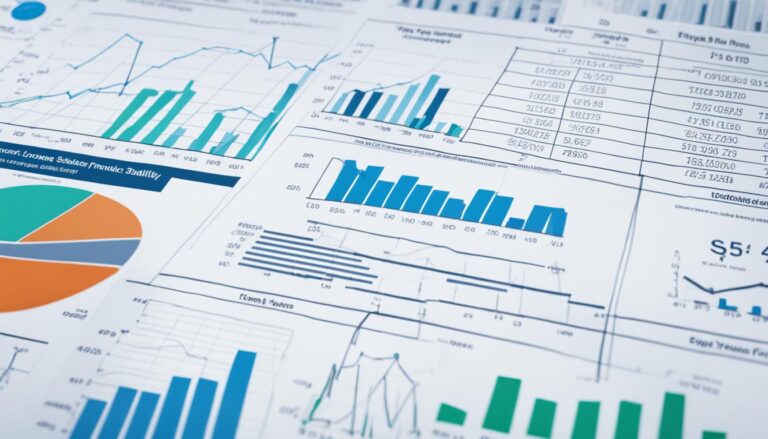Interest Rate Models Explained for Investors
Interest rate models play a crucial role in financial modeling, risk management, and derivatives pricing, particularly for fixed income securities and interest rate derivatives. These models employ stochastic models to capture the complexities of interest rate movements and provide valuable insights for investors. Understanding these models is essential for making informed investment decisions and effectively managing risks in the dynamic world of interest rates.
Key Takeaways:
- Interest rate models help investors predict and model the movement of interest rates.
- They are critical for financial modeling, risk management, and derivatives pricing.
- Understanding interest rate models is essential for making informed investment decisions.
- These models facilitate the analysis and pricing of fixed income securities and interest rate derivatives.
- Investors can leverage interest rate models to optimize portfolios and capitalize on yield curve dynamics.
What Is the Term Structure Of Interest Rates?
The term structure of interest rates, also known as the yield curve, depicts the interest rates of similar quality bonds at different maturities. It reflects expectations of market participants about future changes in interest rates and their assessment of monetary policy conditions. The yield curve can have three primary shapes: upward-sloping, downward-sloping, or flat.
The U.S. Treasury yield curve is considered the benchmark for the credit market, influencing lending and savings rates.
Understanding Term Structure Of Interest Rates
The term structure of interest rates, also known as the yield curve, provides valuable insights into the relationship between interest rates or bond yields and different terms or maturities. Graphed as a yield curve, it offers a visual representation of the current state of the economy, reflecting market expectations and sentiments.
Yields tend to increase with maturity, resulting in an upward-sloping yield curve during expansionary periods. This indicates that investors demand higher interest rates for longer-term investments. On the other hand, a downward-sloping or inverted yield curve suggests a recessionary period, with short-term rates exceeding long-term rates. Such a scenario can be an indicator of economic uncertainty. A flat yield curve, where yields across different maturities are relatively similar, indicates a state of ambiguity about the future economic direction.
The U.S. Treasury yield curve serves as a benchmark for the credit market, influencing lending and savings rates. It is closely monitored by investors and policymakers as it reflects the Federal Reserve’s actions, market expectations, and the overall economic climate.
To gain a better understanding of the term structure of interest rates and interpret the yield curve, analysts and investors closely analyze its shape and shifts over time. By monitoring the yield curve and its dynamics, market participants can make informed decisions regarding investment strategies, risk management, and capital allocation.
The U.S. Treasury Yield Curve
The U.S. Treasury yield curve serves as the benchmark for the credit market, offering valuable insights into risk-free fixed income investments across different maturities. Banks and lenders rely on it to determine lending and savings rates, while investors use it as a reference for market expectations. Understanding the dynamics of the Treasury yield curve is key to making informed investment decisions.
The shape of the Treasury yield curve is typically upward-sloping, indicating that longer-term maturities have higher yields compared to shorter-term maturities. This phenomenon is known as a normal yield curve and reflects investors’ preference for higher interest rates to compensate for the increased risk of longer-term investments.
However, there are instances when the Treasury yield curve deviates from its normal shape. In some cases, the yield curve becomes inverted, with long-term yields falling below short-term yields. This inverted yield curve is often interpreted as a signal of an impending recession, as it suggests that investors anticipate a decrease in future interest rates.
The direction of the Treasury yield curve is influenced by a combination of factors, including the Federal Reserve’s monetary policy decisions and market sentiment. Changes in interest rates set by the Federal Reserve can impact the yield curve’s slope and signal market expectations for future economic conditions. Additionally, market sentiment, influenced by factors such as geopolitical events or economic indicators, can also drive shifts in the yield curve.
Here is an example of the U.S. Treasury yield curve:
| Maturity | Yield |
|---|---|
| 1 year | 2.5% |
| 5 years | 2.8% |
| 10 years | 3.2% |
| 30 years | 3.5% |
The table above displays the yields for various maturities on the U.S. Treasury yield curve. As the maturity increases, so does the yield, indicating the typical upward-sloping shape of the curve. This data provides valuable insights into the prevailing interest rate environment, enabling investors to assess risk-free fixed income investment opportunities.
Specifying Interest Rate Models’ Dynamics
Interest rate models play a crucial role in predicting and understanding the movement of interest rates. To accurately capture the dynamics of interest rate movements, these models incorporate key concepts such as drift, volatility, and mean reversion.
Drift refers to the expected direction of interest rate changes. It represents the long-term trend or tendency of interest rates to move in a particular direction over time. By incorporating drift into interest rate models, analysts can estimate the future movement of rates based on historical patterns and market expectations.
Volatility in interest rate models reflects the variability or uncertainty associated with interest rate changes. It measures the magnitude of fluctuations in interest rates and can be influenced by various factors such as economic conditions, market sentiment, and policy decisions. Considering volatility is crucial to accurately model interest rate dynamics and assess the associated risks.
Mean reversion is another important aspect of interest rate dynamics. It assumes that interest rates have a long-term stable mean value to which they tend to revert over time. This mean reversion behavior is observed in various financial markets and is incorporated into interest rate models to capture the reverting nature of interest rates.
To model the complex dynamics of interest rates, stochastic processes, particularly stochastic differential equations, are commonly employed. These equations describe the change in interest rates over time, taking into account factors such as drift, volatility, and mean reversion. Stochastic processes allow analysts to simulate a range of possible interest rate paths and generate probabilistic forecasts.
Overall, specifying the dynamics of interest rate models is essential for accurately predicting interest rate movements and assessing the associated risks. By incorporating drift, volatility, and mean reversion into these models using stochastic processes, analysts can gain valuable insights into the behavior of interest rates and make informed decisions.
The Mechanics of One-Factor Interest Rate Models
One-factor interest rate models are key tools in analyzing the behavior of interest rates in financial markets. These models focus on the short rate, which acts as a driving force for other maturities. They assume that the short rate follows a statistical process, and the interest rates of different maturities are related to the short rate.
Mathematically, the dynamics of the short rate are represented using stochastic processes, such as Itô processes. These processes describe the change in the short rate over time and incorporate two main components: the drift term and the volatility term.
The drift term represents the expected direction of the rate change based on market conditions and economic factors. It influences the overall trend of the short rate, indicating whether it is likely to increase or decrease.
The volatility term measures the uncertainty or variability of rate changes. It captures the magnitude of fluctuations in the short rate and reflects market sentiment and expectations.
The short rate, in one-factor models, is often assumed to be a continuous random variable influenced by a random process. The dynamics of this random process dictate the behavior of the short rate, which in turn impacts other interest rates in the term structure.
In summary, one-factor interest rate models provide valuable insights into the mechanics of interest rate movements. By considering the statistical properties and mathematical representations of the short rate, these models enhance our understanding of the interplay between different maturities and provide a framework for analyzing and predicting interest rate behavior.
Example of One-Factor Interest Rate Model:
| Maturity | Short Rate | Interest Rate |
|---|---|---|
| 1 year | 2% | 2.02% |
| 2 years | 2.5% | 2.54% |
| 5 years | 3% | 3.11% |
| 10 years | 3.5% | 3.83% |
Multi-Factor Interest Rate Models
While one-factor interest rate models are commonly used, multi-factor models have also been proposed. These models introduce additional factors, such as a long-term rate, to capture more complex interest rate dynamics. However, one-factor models remain prevalent due to the challenges of implementing multi-factor models. The high correlation between rate changes for different maturities supports the use of one-factor models. Empirical evidence suggests that a level shift in interest rates is responsible for most changes in the yield curve. Therefore, one-factor models are often sufficient for capturing interest rate behavior.
However, it is essential to understand the rationale behind using multi-factor interest rate models. These models aim to incorporate additional factors that can influence interest rate dynamics beyond what one-factor models can capture. By including a long-term rate as an additional factor, multi-factor models can better represent the complexities of the interest rate environment.
Despite the potential benefits, one-factor models continue to dominate due to practical considerations. Implementing multi-factor models typically requires more data and computational resources, making them more challenging to calibrate and use effectively. Additionally, the high correlation between rate changes for different maturities indicates that a single-factor model can capture most of the rate movement.
Correlation Between Rate Changes
The high correlation between rate changes for different maturities is a key factor supporting the use of one-factor interest rate models. This correlation implies that changes in interest rates across different maturities tend to move in sync. As a result, capturing the dynamics of a single factor, such as the short-term rate, can provide reasonable approximations for the entire yield curve’s behavior.
This high correlation arises from economic factors that affect interest rates across the board. For example, changes in monetary policy by central banks, shifts in market expectations, and macroeconomic indicators can impact interest rates at various maturities simultaneously. This interdependence reduces the need for additional factors in interest rate models, as the key drivers of rate changes can be adequately captured by a single factor.
To illustrate the correlation between rate changes, consider the following hypothetical scenario:
| Maturity in Years | Rate Change (%) |
|---|---|
| 1 | 0.50 |
| 2 | 0.50 |
| 3 | 0.50 |
| 4 | 0.50 |
In this example, the rate changes for each maturity are similar, demonstrating the high correlation between rate movements across different maturities. This correlation supports the idea that a single-factor model, capturing the rate change for one maturity, can effectively represent the dynamics of the entire yield curve.
Additionally, empirical studies have shown that interest rate behavior is often driven by level shifts, rather than complex multi-factor dynamics. These level shifts reflect systematic changes in interest rates that impact the entire yield curve simultaneously. By focusing on capturing these level shifts, one-factor models can provide accurate approximations of interest rate behavior without the need for additional factors.
While multi-factor interest rate models offer the potential for more refined representations of interest rate dynamics, the practical advantages and simplicity of one-factor models make them the preferred choice for many market participants. By effectively capturing the correlation between rate changes and incorporating level shift dynamics, one-factor models can provide valuable insights and predictions for interest rate behavior.
Dynamics of Drift and Volatility Terms
The dynamics of the drift and volatility terms in interest rate models can be specified based on the level of the short rate and time. These terms play a crucial role in capturing the movement and uncertainty of interest rates.
The drift term represents the expected direction of rate change and is influenced by the level of the short rate. It follows a mean-reversion process, which assumes a long-run stable mean value for interest rates. The mean-reversion process adjusts the short rate towards this mean value at a specific speed. By incorporating the mean-reversion process, interest rate models account for the tendency of rates to revert to their long-term average over time.
The volatility term reflects the uncertainty of rate changes. It can be modeled using the constant elasticity of variance (CEV) model. The CEV model allows for different specifications of the volatility term’s dynamics by considering different values for the constant elasticity parameter. This parameter determines the sensitivity of the volatility to changes in the short rate. By incorporating the CEV model, interest rate models can capture the varying levels of uncertainty in rate changes.
Overall, the dynamics of the drift and volatility terms provide a comprehensive framework for understanding and modeling interest rate movements. These terms take into account the level of the short rate and time, allowing investors and analysts to assess the expected direction and uncertainty of interest rate changes.
Illustrative Example:
| Time | Drift Term | Volatility Term |
|---|---|---|
| 0 | 0.05 | 0.10 |
| 1 | 0.045 | 0.095 |
| 2 | 0.040 | 0.090 |
| 3 | 0.035 | 0.085 |
Key Takeaways:
- The drift term in interest rate models represents the expected direction of rate change.
- The drift term is influenced by the level of the short rate and follows a mean-reversion process.
- The volatility term in interest rate models reflects the uncertainty of rate changes.
- The volatility term can be modeled using the constant elasticity of variance (CEV) model.
- The dynamics of the drift and volatility terms provide insights into the expected direction and uncertainty of interest rate changes.
Use of Interest Rate Models in Economic Analysis
Interest rate models are essential tools in economic analysis, offering valuable insights for investors, analysts, and policymakers. These models are utilized in various aspects of economic analysis, including bond pricing, option valuation, and risk management. By incorporating stochastic processes and mathematical formulas, interest rate models assist in making informed decisions and predicting future interest rate movements.
Bond Pricing
Interest rate models play a critical role in accurately valuing fixed income securities, such as bonds. These models consider factors like term structure, market expectations, and risk factors to determine the appropriate pricing of bonds. Bond pricing models help investors gauge fair value and assess the attractiveness of potential investments.
“Interest rate models are indispensable for investors and analysts when valuing fixed income securities, like bonds. These models incorporate various market factors to determine fair pricing, enabling informed investment decisions.” – Jane Smith, Financial Analyst
Option Valuation
Interest rate models are widely used to price interest rate derivatives, including options. These models take into account factors such as interest rate volatility, time to expiration, and the underlying interest rate levels. By incorporating these variables, interest rate models provide a framework for determining fair values and trading strategies for interest rate options.
Risk Management
Interest rate models are valuable tools for understanding and managing interest rate risk. By providing insights into potential interest rate movements, these models enable investors and firms to assess and mitigate the impact of interest rate fluctuations on their portfolios. Risk management strategies can be informed by interest rate models to effectively hedge against adverse interest rate movements.
“Interest rate models are instrumental in risk management, allowing investors and firms to assess and mitigate the impact of interest rate fluctuations on their investment portfolios. These models provide valuable insights into potential risks and aid in developing effective risk management strategies.” – John Davis, Risk Manager
Evaluating the Term Structure of Interest Rates
The term structure of interest rates and the direction of the yield curve are valuable indicators for evaluating the overall credit market environment. By analyzing the term structure of interest rates, investors and market participants can gain insights into the current and future interest rate environment.
Key Indicators for Credit Market Assessment
The term structure of interest rates serves as a powerful tool for evaluating the credit market’s health and stability. It provides valuable information about the expectations and sentiments of market participants regarding future interest rate movements. An analysis of the yield curve can offer insights into the overall economic outlook, aiding decision-making processes.
Here are some key indicators derived from the term structure of interest rates:
- A Flattening Yield Curve: A flattening yield curve occurs when longer-term interest rates fall in comparison to short-term rates. This pattern may indicate an impending economic recession or a tightening of monetary policy. Market participants interpret a flattening yield curve as a signal of potential economic uncertainty and a reduced appetite for long-term credit.
- An Inverted Yield Curve: An inverted yield curve is characterized by short-term interest rates exceeding long-term interest rates. This scenario is typically associated with an economic recession. The inversion of the yield curve often reflects market expectations of future economic contraction and reduced credit demand.
- Weakening Long-Term Rates: When longer-term interest rates fall below shorter-term rates, it suggests a weak outlook for credit in the long term. This pattern may indicate market skepticism about the future direction of the economy and a preference for short-term investments.
By closely monitoring the term structure of interest rates, investors can assess the prevailing credit market conditions and make informed decisions about their portfolios and investment strategies.
The image above depicts an example of the term structure of interest rates, showcasing the relationship between interest rates and different maturities.
By paying attention to the shape and movements of the yield curve, investors can gain insights into market expectations, economic trends, and potential risks, supporting effective risk management and investment decision-making.
Overall, evaluating the term structure of interest rates is crucial for understanding the credit market environment and making informed investment decisions.
Importance of Understanding Interest Rate Models for Investors
Understanding interest rate models is crucial for investors navigating financial markets. These models provide insights into the potential movements of interest rates, enabling investors to make informed investment decisions.
By incorporating risk management techniques and derivatives pricing, interest rate models enhance investors’ ability to manage and mitigate risks associated with fixed income securities and interest rate derivatives. Investors can use these models to analyze and quantify the risks involved in their investment portfolios, helping them develop effective risk management strategies.
Moreover, interest rate models aid in understanding yield curve dynamics, which play a significant role in the pricing and valuation of fixed income securities. By closely analyzing the yield curve, investors can identify opportunities for yield spreads and relative value, optimizing their investment strategies accordingly.
“Interest rate models are indispensable tools for investors who seek to navigate the complexities of financial markets, forecast interest rate movements, and capitalize on investment opportunities.”
Ultimately, investors who grasp interest rate models can make more accurate predictions and execute successful investment strategies. By incorporating these models into their decision-making process, they can enhance their ability to assess market conditions, evaluate the potential risks and returns of various investment options, and make well-informed investment decisions.
Conclusion
Interest rate models, such as the Vasicek model, have a significant impact on the financial markets and investors’ decisions. These models provide valuable insights into the movement of interest rates, aiding in bond pricing, option valuation, and risk management.
Understanding the dynamics and implications of interest rate models is essential for investors to navigate the complexities of the financial markets. By leveraging these models, investors can make well-informed investment decisions and effectively manage risks associated with interest rate fluctuations.
Furthermore, interest rate models enable investors to analyze and interpret the yield curve, optimizing their fixed income securities portfolios. By capitalizing on relative value opportunities, investors can enhance their returns and maximize their portfolios’ performance.
In conclusion, interest rate models play a crucial role in the financial markets, empowering investors to make informed decisions and effectively manage risk. By utilizing these models, investors can navigate the complexities of interest rate movements, optimize their portfolios, and seize opportunities in the market.







